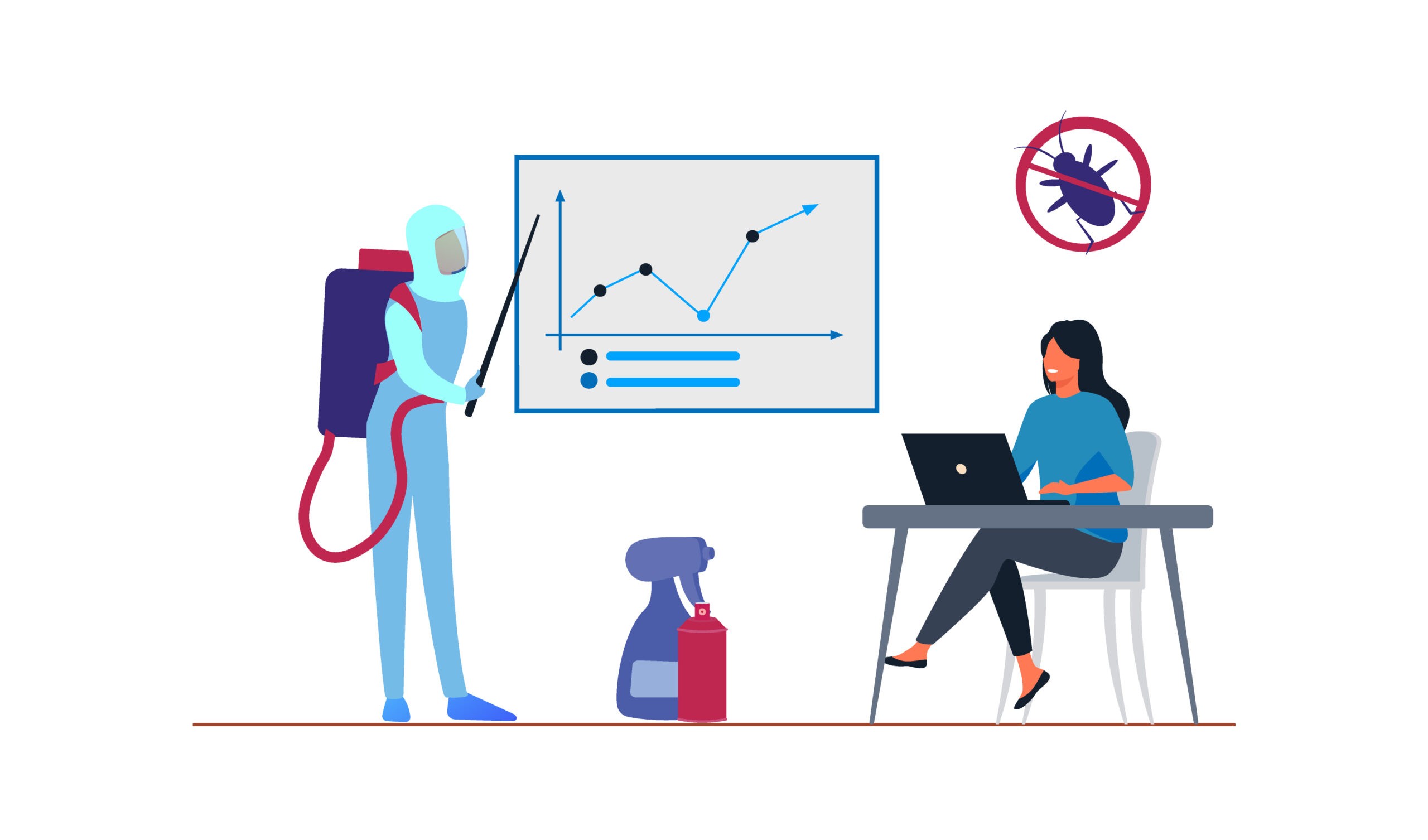Marketing your pest control business is no easy feat.
Why?
Because you’re selling a commodity. You and the other 29,535 pest control companies do essentially the same thing — you get rid of bugs and maybe wildlife.
And when you sell a commodity with no differentiation, it’s a race to the bottom on price.
This is especially true when you’re just starting. In the long run, you can get away with growing your pest control business while not being different.
The following two strategies can get you there:
- Brand — Consumers know who you are.
- Online reputation — you have tons of online reviews, and customers love you.
But those things take a lot of time and resources to build. If you want to accelerate growth, you need to ask yourself, “How do I differentiate my pest control business from my competitors?”
You may have come here thinking you would get a list of pest control marketing tactics like SEO, social media marketing, networking, hostings events, email marketing, or PPC advertising — and we will get into those.
But every one of those channels will fall flat or give you average results at best if you don’t give people a compelling reason to choose you over your competitors.
That’s why we are going to start with differentiation.
Differentiation: What does it mean to be different?
To be different means to stand out, and in doing so, you are (hopefully) memorable as well.
One of the first questions I ask new clients is, “What do you do differently and better than any of your competitors?”
Frankly, most clients don’t have good answers. It’s usually something like:
- “We’re honest.”
- “We have been in business for 10 years.”
- “We’re thorough.”
- “We care about our customers.”
There’s nothing inherently wrong with these answers, but they don’t actually answer the question.
Why?
Because when most of you guys answer the same way, it means that, by definition, what you are saying is not different!
Different Service Offering vs. Different Messaging
Now, here is where marketing becomes a funny thing.
Marketing is a battle of perceptions, not quality.
What I mean by this is that your service doesn’t have to be different or better to stand out.
What has to be different is your messaging.
I can see that you’re probably scratching your head right now, wondering if I’m bipolar.
“Be different, or you won’t get good results!”
“You don’t have to be different to get good results!”
So, what gives?
I’ll explain visually.
Here is what most pest control landing pages look like…
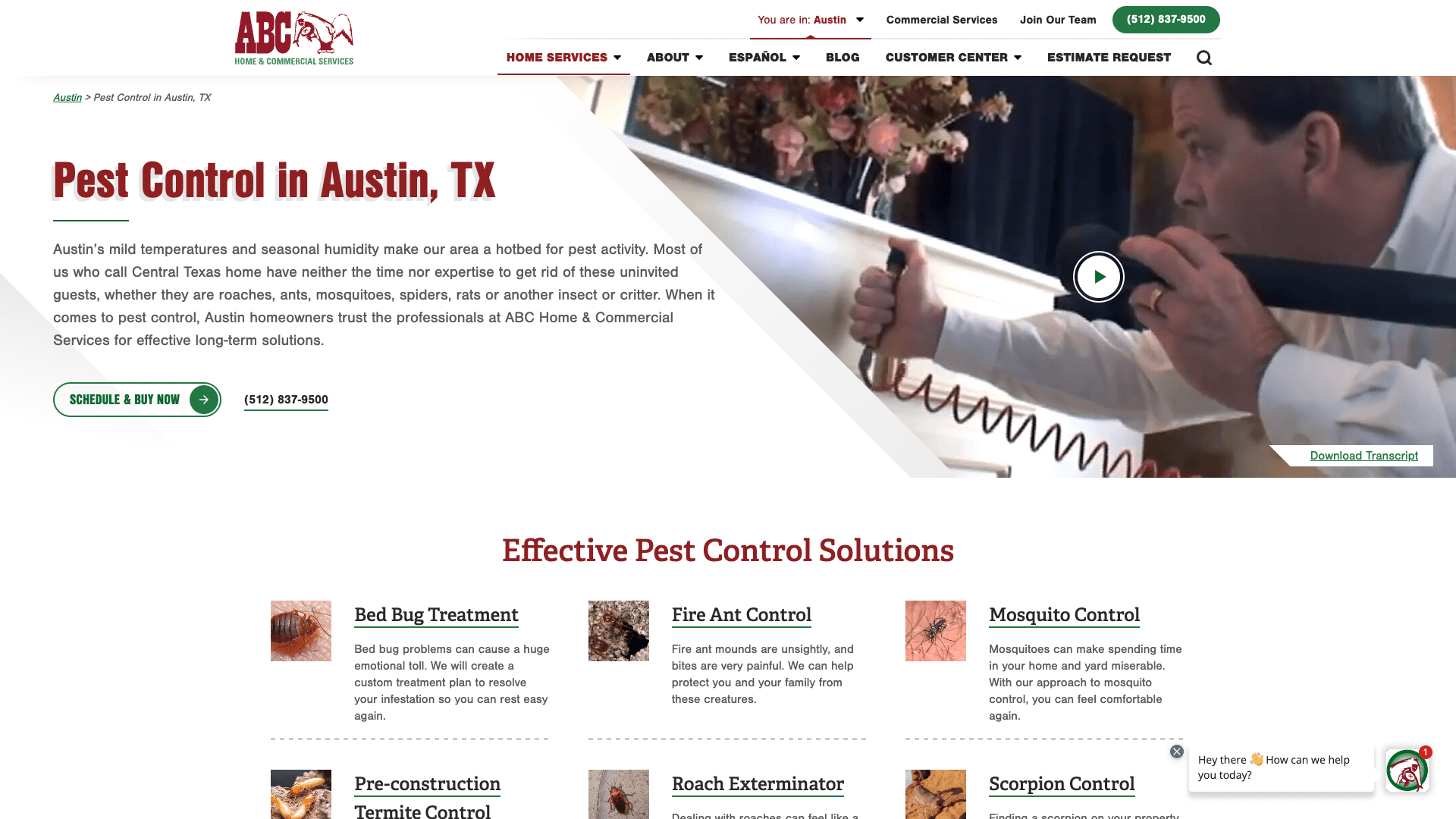
This is where a potential customer lands after clicking on ABC Home and Commercial’s ad in Google Ads.
Pretty standard, right?
And therein lies the problem.
Below is a landing page we built for a client.
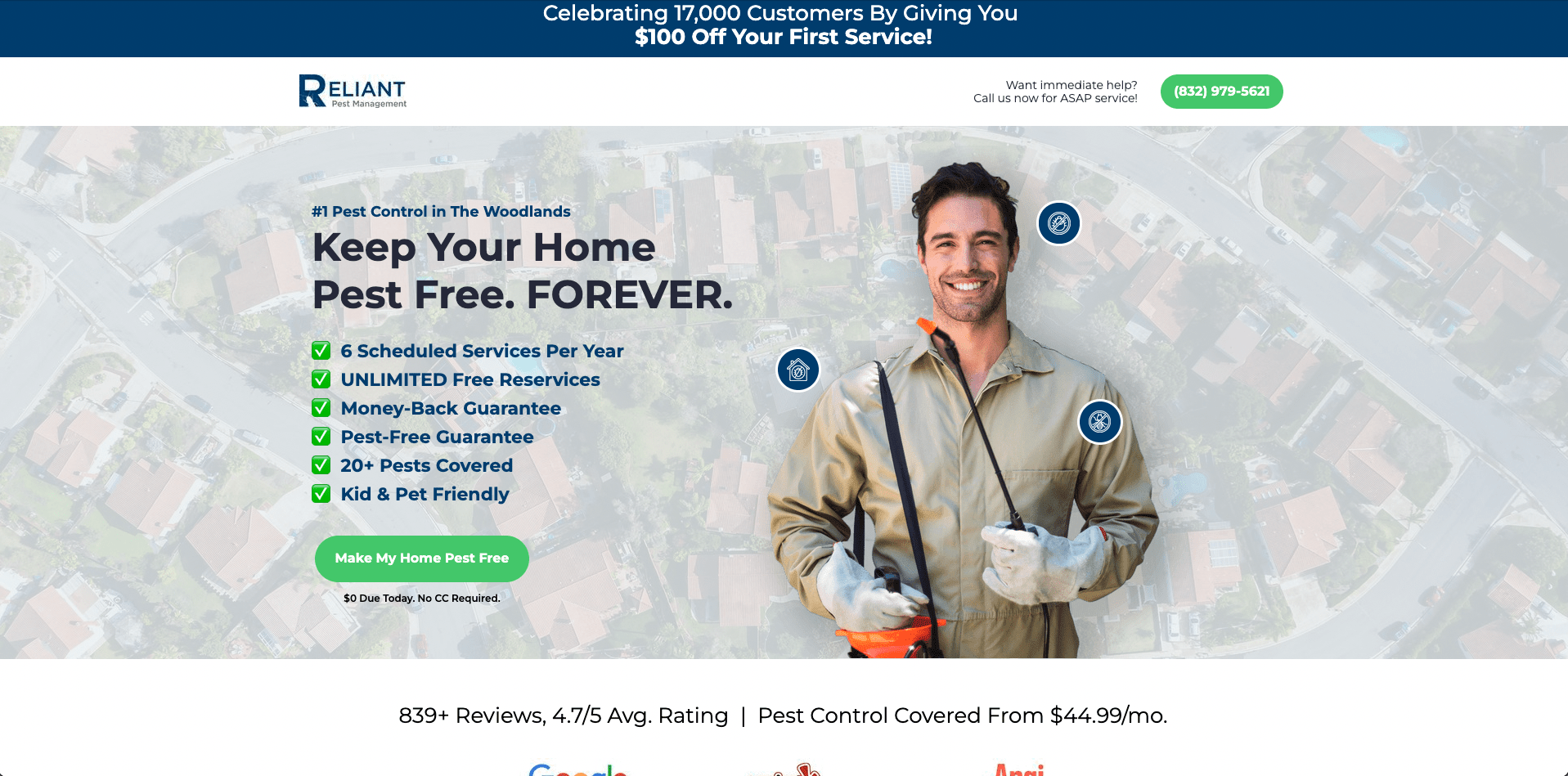
See the entire landing page we built here.
Instead of simply saying, “Hey, we do pest control in The Woodlands”, we immediately try to differentiate our service offering from all others the consumer is researching.
We differentiate throughout the page, but to keep it simple, we’ll focus on the top of the page.
The first area we use to differentiate is by listing the features and benefits of the services:
- 6 scheduled services per year
- Unlimited free reservices
- Money-back guarantee
- Pest-free guarantee
- 20+ pests covered
- Kid & pet friendly
We also do this below the CTA (call-to-action) button where it says, “$0 Due Today. No CC Required.”
What’s important to recognize here is that you probably offer the same or very similar features and benefits in your service.
But how well do you communicate those features and benefits in your marketing?
In August 2022, this page converted 25.58% of visitors into leads. That means one in every four visitors who landed on this page turned into a lead. How does this compare to the conversion rate of your landing page? If you don’t know, then I can tell you from the data we see, it’s probably hovering around 2–5%.
There are a lot of important strategies that go into the success of this landing page, and differentiation is one of the strategies which plays a key role in that success.
Now, ideally, your service is different or better than your competitors.
Because when it is actually different or better, other benefits such as word-of-mouth marketing and an increased customer lifetime value start to work in your favor.
Now that you understand the value of differentiating your service, the next step is to figure out how to differentiate yourself.
The best exercise for doing this is to list out every feature and benefit of your service.
I’m a spreadsheet nerd, so that’s where I do my list writing, but you can do this by hand too — whatever works for you.
Below is an example of the kind of list I’m talking about.
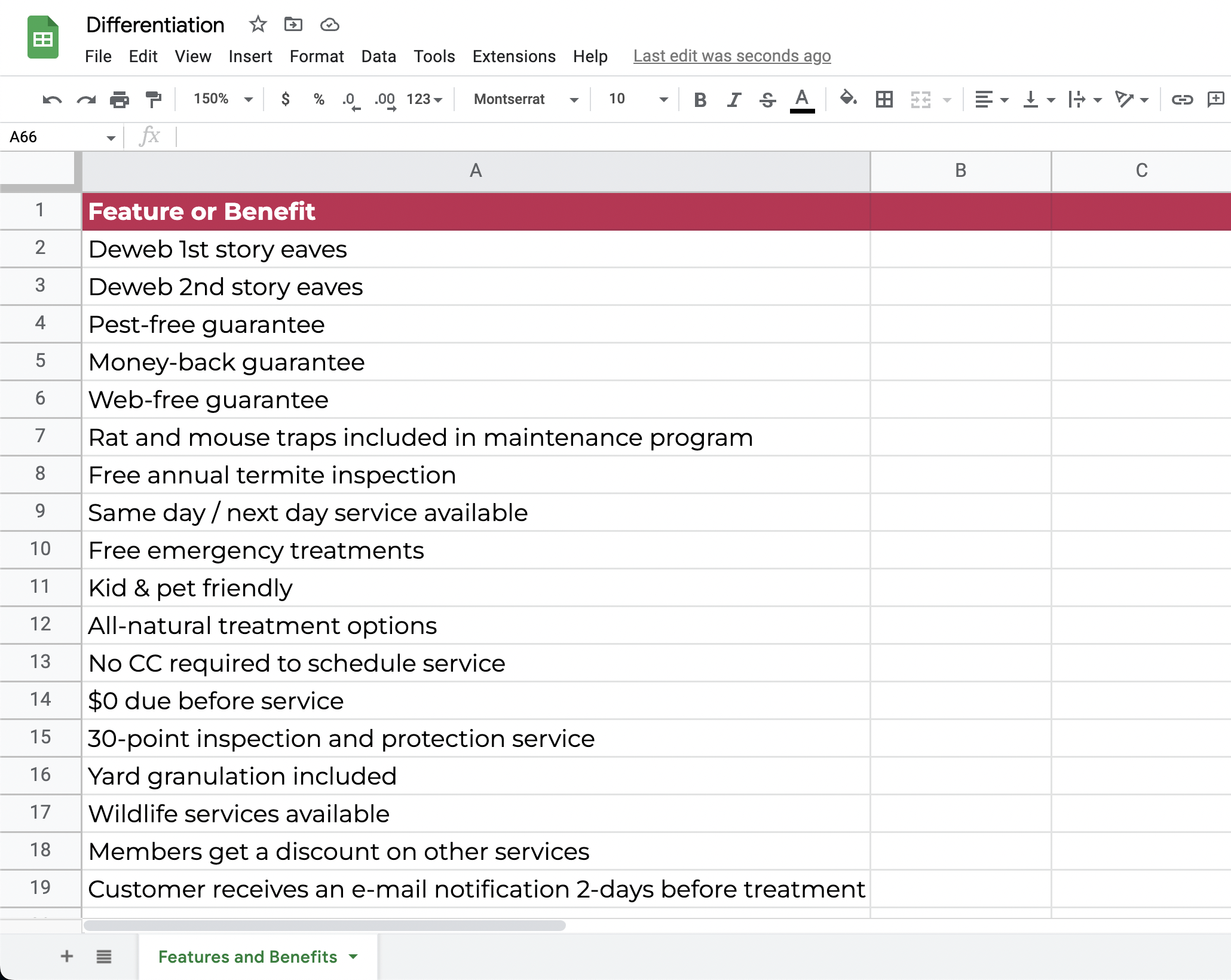
Now that you’ve got your list, add them to you landing page or website. If you have conversion tracking in place, track the conversion rate before making this change vs after and see the difference it makes for yourself.
| Are you looking for help differentiating your service and increasing the number of leads you get? Are you looking for a marketing partner who can implement this type of data-driven strategy for you? Get in touch with us today to see if we’re a good fit to work together. *To avoid a conflict of interest, we only take on one client per city. Contact us to see if your city is available. |
I started with differentiation because it’s a fundamental piece of your marketing strategy that can work on any channel whether it’s online or offline, Facebook or Google, flyers or magazine ads.
Next, we’ll look at a few marketing channels you can use to get directly in front of your target customer.
Where to Market Your Pest Control Services
We specialize in organic and paid search engine marketing. We don’t do social media marketing (yet). So, instead of giving you generic advice about channels we don’t have data and experience in, we’re going to focus on what we know best.
This is the best way for us to give you advice that is actually helpful.
Below, we’ll dive into:
- Holistic SEM (Search Engine Marketing)
- Paid Search Advertising (aka PPC Advertising)
- Local SEO
- Organic SEO
We’re going to start with Holistic Search Engine Marketing.
Holistic SEM (Search Engine Marketing)
This is a term I coined a couple of years ago.
Holistic SEM is the process of getting in front of your potential customers in as many places as possible on a local search engine results page (SERP) and creating a positive brand experience at each touch point.
The SERP is the page you see when you perform a search on a search engine.
Since 81% of consumers use Google to evaluate local businesses, we’ll use them as our search engine of focus moving forward.
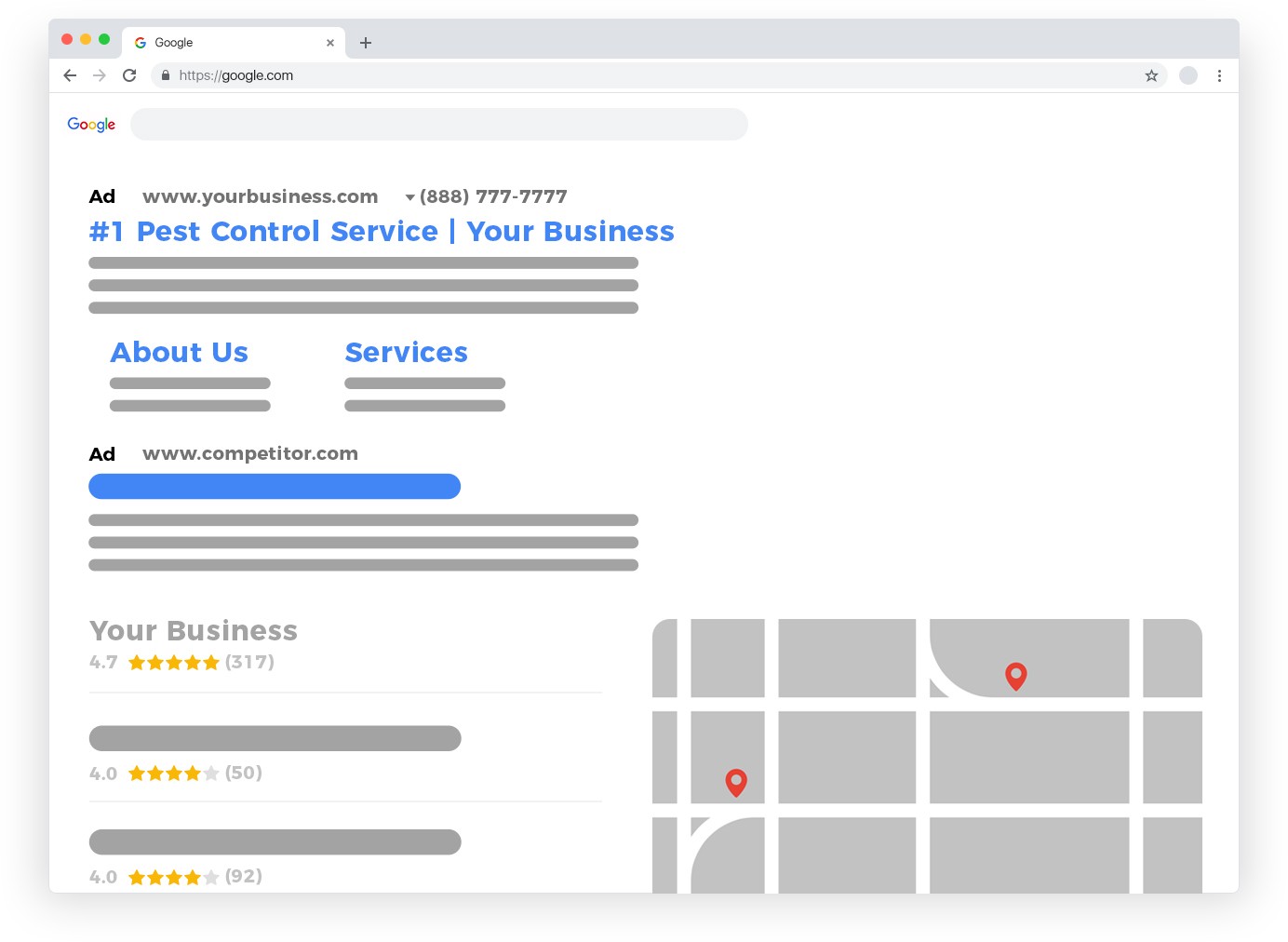
Getting In Front of Your Potential Customers
When looking for a service and selecting the business they will use, consumers conduct their research in many different ways.
This journey the consumer goes on is what we call the messy middle.
And this is one reason why our goal is to be in as many places as possible. We want to minimize the chance that the consumer doesn’t see us and maximize the number of times they do see us.
By showing up over and over again, we are also trying to get the consumer familiar with our brand as quickly as possible.
As a result of being familiar with something, consumers tend to develop preferences for it. In psychology, this is known as the mere exposure effect or the familiarity principle.
The more times a consumer sees our pest control brand, the more familiar with it they are, and the more they will develop a preference for it.
On a Google SERP, there are four areas where your pest control business can show up:
- Local Service Ads
- Search Ads
- Map Pack
- Organic Search Results
We’ll get tactical with each of these marketing channels below, but first, what does it mean to create a positive brand experience at each touch point (part two of the Holistic SEM approach)?
Creating a Positive Brand Experience
Creating a positive brand experience means that whenever someone sees the name and/or logo of your company, it is in a positive light.
If a consumer clicks on your ad, the landing page should work and make it easy for the consumer to contact you.
If a consumer sees your Google Map Pack listing, it should have a high star rating with people saying positive things about your company and service.
If a consumer clicks on a directory link like Yelp, Angi, or HomeAdvisor you should show up as high on the list as possible and with as many positive reviews as possible.
If you’ve executed the Holistic SEM approach effectively, then by the time a consumer has done all their research, you are the obvious choice for them to buy from.
Paid Search Advertising (aka PPC Advertising)
Taking up as much real estate as possible on a SERP means starting from the top. In the case of pest control, that means leveraging Google’s Local Service Ads (aka LSAs).
| Warning! It’s important you have conversion tracking set up on your website before you start spending money on ads. With conversion tracking, you will know where every lead came from and can calculate what it cost you to acquire each lead. Without it, you won’t have a clue what your ROI is. |
Local Service Ads
LSAs are great because they require very little strategy and maintenance. Any PCO can go through the application process and start getting pest control leads without knowing anything about marketing.
Google gives you a “Google Guaranteed” badge and displays your star rating based on customer reviews. These trust signals make your company more trustworthy and less risky to purchase from.
When a consumer clicks on an LSA ad, they’re taken to a landing page made for you by Google. This means you don’t have to send traffic to a landing page you designed and puts you and your competitors on a level playing field.
It’s like advertising with training wheels.
That lack of control can also be a major downside though. There are a number of downsides to LSAs, but a big one that we discussed earlier in this article is the lack of differentiation.
Since everyone’s ads and landing pages look so similar, you lose the competitive advantage of differentiation and rely more heavily on the strength of your brand. When you’re up against companies like Terminix or Orkin which have big powerful brands, this can be challenging.
If you want more control, this is where Google’s Search Ads come into play.
Search Ads
With Search Ads, you have much more control over every aspect of your advertising campaign. You can choose the keywords you target, what your ads say, where your ads show geographically, and where you send consumers who click on your ads.
Google offers two different kinds of Search Ads, Smart Mode and Expert Mode.
Smart Mode
Smart Mode is the simplified version of Google Ads. Similar to Local Service Ads, it was designed to simplify the advertising experience.
Every campaign in Smart Mode is a Smart campaign. Smart campaigns let you choose your business goals and where you want to advertise, then Google uses machine learning to deliver real results tailored to those goals, like phone calls or actions on your website.
If you run your own campaigns, it’s likely you will use Smart Mode.
Expert Mode
Expert Mode offers the full range of Google Ads features and campaign types. While it gives you more complete control over your bidding strategies, it also requires more complex management. For this reason, Google only recommends it for advanced marketers and advertisers.
The Search Ads Expert Mode is one of the areas that we specialize in at Pesty Marketing.
Below is our framework for finding success on Google Ads Expert Mode.
Google Ads’ success comprises six parts:
- Targeting
- Ad Relevance
- Click-Through Rate
- Landing Page Experience
- Offer
- Reputation
Targeting Overview
Optimal Targeting means we’re hyper-targeted with our keywords and cities. This ensures we are getting in front of the people most likely to purchase from us. Some ways we do this include:
- Targeting only people who are physically in or often physically in the target areas. By default, Google will show your ads to consumers who may be interested in but are not physically in your target areas.
- Only running ads during office hours when someone can answer the phone
- Targeting individual cities rather than targeting multiple cities at once
Ad Relevance Overview
Optimal Ad relevance means our ads are consistent with the search intent of the keyword. This means that when someone searches for “pest control in Atlanta”, for example, they see an ad that is clearly offering pest control services in Atlanta. Some ways we do this are:
- Including the keyword in the first headline and the first description of the ad
- Describing an offer in the ad that is meant for consumers looking for pest control services
- Including features and benefits of your pest control service
Click Through Rate (CTR) Overview
Optimizing the CTR starts with getting the Targeting and Ad Relevance right. Other strategies include:
- Using numbers (100% Effective, #1 Pest Control Service, 365-Day Guarantee, etc)
- Using ad extensions
- Having a strong offer
Landing Page Experience Overview
An optimal Landing Page Experience means our landing page is consistent with the search intent of the keyword and consistent with the ad the consumer clicked on. Some ways we do this are by including:
- The keyword in the landing page header
- Clear Call to Action buttons throughout the page
- A helpful FAQ section
- A Google Map of your nearest Google Business Profile
- The offer, features, and benefits of your service throughout the page
- Scheduling a treatment is fast and easy
- On a mobile device, the phone number should begin calling when clicked
Offer Overview
A strong offer is clear, valuable to your customers, and different from what the competition is doing. Examples of a strong offer that I’ve seen work include:
- Rodent Protection included in year-round maintenance service
- One year of termite protection free
- Money-Back Guarantee
- Web-Free Guarantee
Reputation
Your online reputation is important for two reasons. The first is that you need to use your testimonials on your landing page. The second is that sometimes consumers will search for your company reviews online before they decide to do business with you.
If you don’t have reviews on your landing page, skeptical consumers are less likely to purchase your services.
If you have few or poor reviews online, well-researched consumers are less likely to purchase your services.
Execute all six of these components effectively and you’ll be able to dial up or turn down your lead funnel as you please.
That’s one of the reasons why paid advertising on Google is so great. You put money in and immediately get traffic, leads, and sales.
It’s also why paid advertising is so expensive. And as soon as you stop paying, the traffic, leads, and sales go away.
For clients just getting started, I usually recommend they leverage paid ads to get immediate sales and ROI from their advertising dollars.
In the long run, though, you’ll get leads at a lower cost with organic search traffic. This is where SEO comes into play.
Local SEO
When we are referring to local SEO, we are talking about the Google Map Pack. The Google Map Pack is the term used to describe the list of businesses that Google shows on a map.
This list is shown at the top of Google’s local search results when a consumer searches for “pest control”. Usually, it sits below the ads.
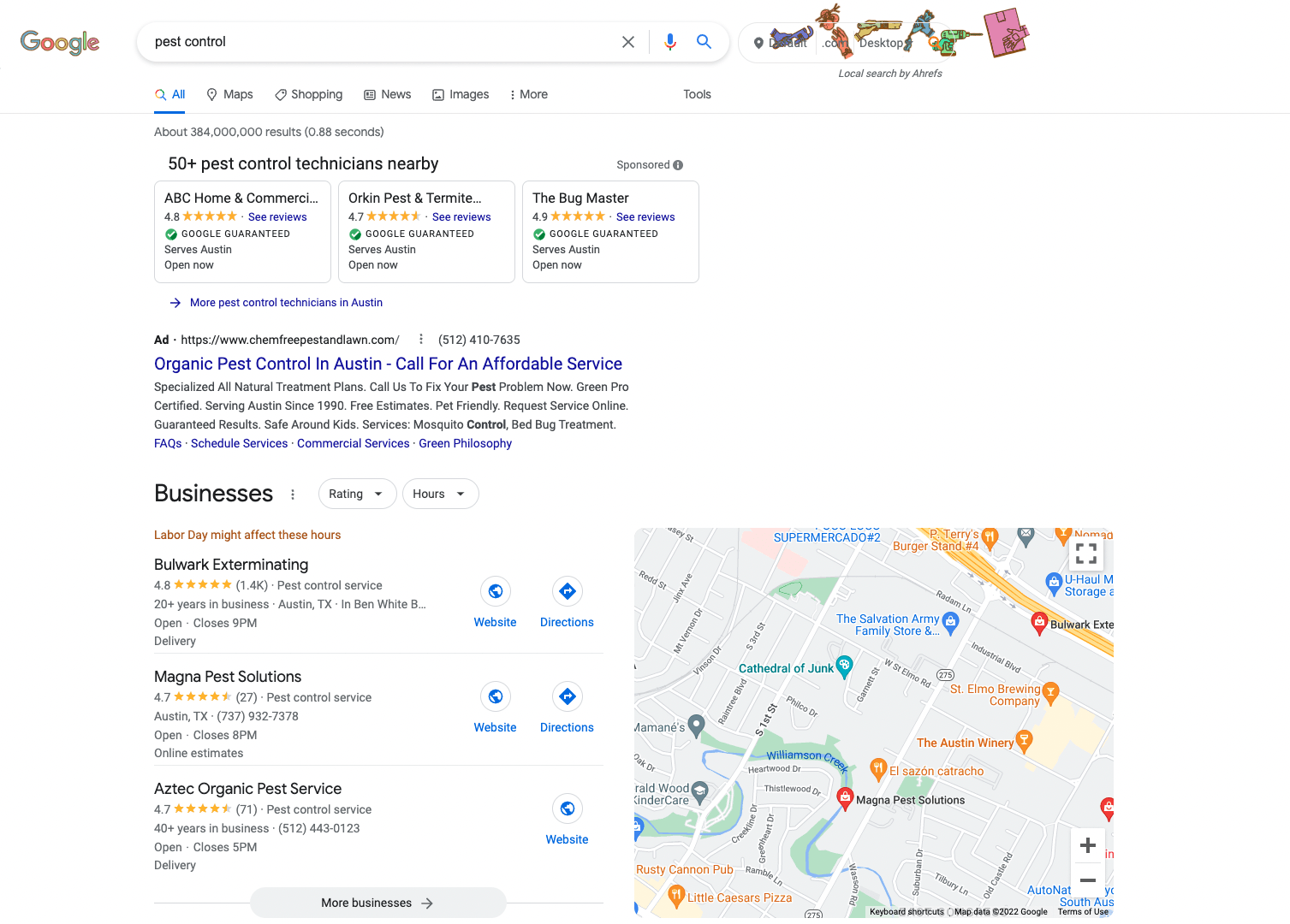
The reason we’re starting this list with local SEO is that it is the most cost-effective way for you to get leads and sales.
The reason for this is three-fold:
- It doesn’t cost you anything to create a listing.
- Consumers will call you directly from Map Pack which means you’re less reliant on the effectiveness (re: conversion rate) of your website.
- When a consumer sees you have great reviews they are much more likely to buy from you.
Getting listed on Google is straightforward. Simply sign up, follow their instructions, verify your location, and voila! You’re all set.
Factors That Affect Your Google Map Pack Ranking
Now that you have a listing, the question becomes, how do I outrank everyone else? The three factors for you to focus on are:
- Proximity to searcher
- Reviews and ratings
- Landing page
Proximity to Searcher
The number one ranking factor is your location’s proximity to the searcher. If a consumer is just down the street from your office and they search for “pest control”, it’s likely that your listing will show up.
The further I am from your location, the closer I am to your competitors which means your competitors are more likely to outrank you.
If you haven’t chosen a location yet, then you’ll want to consider where you open up shop. Having an office near your target market will ensure that you show up when they’re looking for your services on Google.
Most likely though, you already have an office, so this may be out of your control.
The next most important ranking factor is the number of reviews and quality of your star rating.
Reviews and Rating
At this point, you might be looking around thinking, “Oh crap, my competitors have hundreds of reviews and I have zero. How am I ever going to compete?”
First, realize that this is out of your control and you have to start somewhere.
Second, while the total number of reviews matters, this ranking factor is more nuanced than that.
Both Google and consumers don’t give the same weight to all reviews. Some of the ranking factors that are taken into consideration when it comes to reviews are:
- Recency of reviews
- Quality of reviews
- Star rating
Recency of Reviews
Take a look at that screenshot of the Map Pack above, again. 13 of Magna’s 27 reviews were acquired in the last month.
None of Aztec’s 71 reviews were acquired in the last month.
Advantage — Magna.
Not only does Google take the recency of reviews into consideration, but so do consumers.
A recent survey by local search marketing software company Brightlocal revealed that:
- 22% of consumers only pay attention to reviews written in the last two weeks.
- 73% of consumers only pay attention to reviews written in the last month.
- 86% of consumers only pay attention to reviews written in the last three months.
For this reason, you can still win in the Map Pack even if you are way behind your competitors.
This also emphasizes the importance of consistently acquiring reviews.
You can get reviews manually by asking your customers to leave you reviews or you can leverage a review management software that will do the heavy lifting for you.
I recommend you do both.
A good review management software will enable you to text and email your customer a review request. If the customer doesn’t give a review, the software will automatically follow up with the customer.
Even with the best intentions, people get distracted, get busy, and life happens. The follow up requests will at least double the amount of reviews you get.
We make sure all of our clients use a review management software, whether its ours or their own.
Quality of Reviews
Another ranking factor for reviews is the quality of those reviews. When a customer leaves a star rating and doesn’t write anything about the service, that review won’t be given as much weight.
Did you ever notice how when you look at reviews of a company, Google shows the most descriptive at the top?
That’s because they know that descriptive reviews are more useful to you, and they take this into account when deciding the value of a review and the weight they give it in their rankings.
How descriptive your reviews are largely comes down to the quality of your service.
88% of consumers say they would be ‘likely’ or ‘highly likely’ to leave a review if the business went above and beyond to ensure they had an exceptional experience.
If a customer is happy with the service, feels connected to your brand or their service technician, or especially when they feel you’ve gone above and beyond to take care of them, they tend to be more descriptive.
To wrap up the reviews and ratings section, I’ll leave you with a few more data points:
- Respond to all of your reviews. 89% of consumers would be ‘likely’ or ‘highly likely’ to use businesses that respond to all reviews. And at the other end of the scale, 22% say they’re ‘not likely at all’ to use businesses that don’t respond to any reviews at all.
- Try to amend negative experiences. 80% of consumers say they would be ‘likely’ or ‘highly likely’ to leave a positive review if they initially had a negative experience that was turned into a very positive experience.
- Share that you’re family owned. 74% of consumers say they would be ‘likely’ or ‘highly likely’ to leave a review if they knew that the business was family-owned, while only 43% feel the same about a large chain.
- You don’t need to perfect. The percentage of consumers who would only use a 5‑star business has fallen from 12% in 2020 to just 4% in 2021.
Landing Page
When you set up your Google Business Profile, Google is going to want to know where to send people who click on your “Website” link.
When you do this, you want to send the consumer to the most relevant page on your website. If you only serve one market, then this will likely be your homepage.
But if you have multiple locations, then you want to send the consumer to a page that specifically designed to address their needs. This means sending them to a page that is relevant to the city they are in.
Let’s say, you have two locations. One is in Austin, TX and the other is in Houston, TX.
The consumer who is in Austin should be sent to a landing page that talks about your service offering in Austin, answers frequently asked questions about pest control in Austin, illustrates your service area in Austin, and makes it easy to find the contact information for your office in Austin.
The same applies to Houston or any other location for that matter.
When the consumer clicks your website link and is taken to this page that has been designed to address their needs, they experience frictionless continuity between what they expected to find (information about pest control services in Austin, TX) and what they do find.
They don’t have to look around your website to find the information most relevant to their needs which is what happens if you send them to your homepage even though you have multiple locations
Google also takes this into account and rewards profiles that have the most relevant information on the landing page the consumer is directed to.
And speaking of location pages, next we’re going to talk about organic SEO, and your location pages can play a critical role in the success or failure of your organic search rankings.
Organic SEO
Organic SEO are the links below the Map Pack.
When consumers do a search for “pest control”, most of what they’ll see are pest control companies in this area.
Directory Pages
They may see directories such as Yelp and Angi, and a page from This Old House seems to show up everywhere nowadays as well.
Ideally, not only does your website rank here, but you also have high-ranking listings on Yelp, Angi, and This Old House.
Circling back to the familiarity principle we discussed earlier, showing up everywhere increases trust. Therefore, your goal is to be anywhere your client may look including on these directory pages.
Getting a listing on Yelp and Angi is easy. You can sign and get reviews on both for free. This Old House only promotes Terminix, Orkin, and one large local company. This is because they get a kickback from every lead they get for those companies and likely require a company to be of a certain size to add them to the list.
Create the Yelp and Angi listings and get at least some reviews on both platforms.
Now, let’s focus on your website.
Your Website SEO
The success of your SEO hinges on two overarching themes; relevance and authority.
What is your website related to and how much authority do you have on the topic?
The way you create relevance and authority is by publishing content and building links (aka link building).
Let’s start with publishing content.
Relevance (Publishing Content)
Think of your website as a hub of helpful information for your customers.
Your goal is to answer all questions your target customers have about your company and pest control and to answer them well.
To answer them well means to answer them thoroughly; to be helpful as Google would put it.
A good place to start is by answering the obvious questions such as:
- What services do you offer?
- What customers do you serve?
- What service areas do you cover?
- Who is your company?
- How do I contact you?
From these questions, we can start to build a sitemap. A sitemap lists all the pages that are on your website. A basic sitemap that answers the questions above might look like this:
- Homepage
- Services
- Residential
- Commercial
- Services Areas
- Service Area 1
- Service Area 2
- Service Area 3
- About
- Contact Us
These pages show consumers and Google who you are and what you do. You probably already have them on your website and if you do, it’s likely clear to Google that you are a pest control company. But if this is all you have, you’re probably not going to be ranking anywhere near the top for “pest control” in your target areas.
Pesty Pro Tip: With the exception of the Contact page, make sure you have at least 300 words of content on each page. There is no hard-and-fast rule for this, but if you have less content than this, it likely means that there is more information that you can share that is important for your potential customers to know.
To be competitive, you can’t have the bare minimum.
You need to establish yourself as an authority on the topic of pest control in your target area.
To do so, you can expand your sitemap to create pages about each service you offer. If you offer bed bug control, create a bed bug service page. If you offer termite inspections and termite control, create a page for each service. If you offer these services in every service area, then every service area should have its own pest control, bed bug, termite inspection, and termite control page.
What you end up with is a web of content for each area that looks like this.
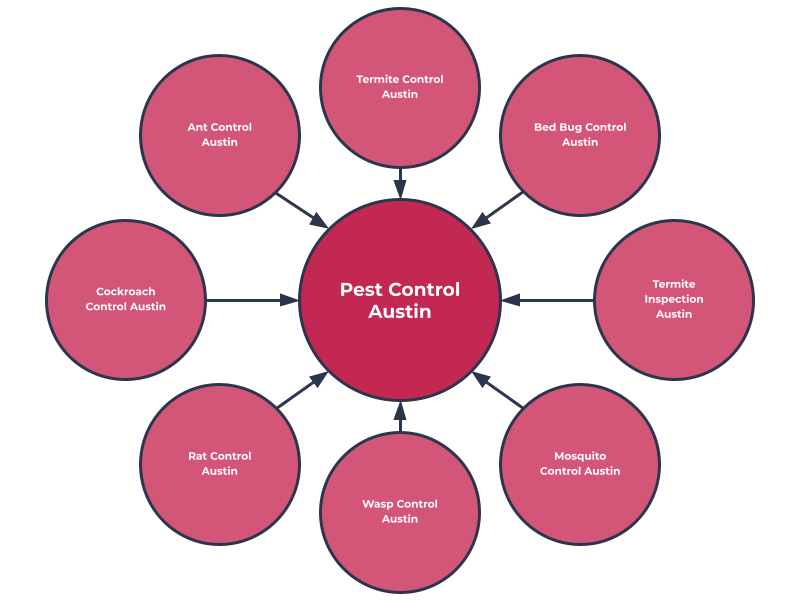
This kind of structure starts to show consumers and Google that you are an authority on the topic of pest control in each area you service.
Authority (Publishing Content And Getting Backlinks)
To continue expanding your authority through publishing content, you can write articles on your blog to answer other questions that your target customers have.
Another way to establish authority is by building links. If you’ve done any homework on SEO before, you’ve probably come across this strategy.
But how do you actually build links?
Link building is the hardest part of SEO and without an experienced team doing it for you, you’re limited to what you can accomplish here.
The easiest way to build links includes:
- Creating profiles on local business directories like Yelp, Angi, Homeadvisor, etc.
- Getting a link from your local chamber of commerce
- Sponsoring local events
- Offering a local scholarship
- Local press
Local Business Directories
Do a search for “pest control companies in city”. Replace “city” with your city. Look through the business directories that show up and see if you can get your own listing.
Chamber of Commerce
If you’re a part of the local chamber of commerce, see if they will link to your website..
Sponsor Local Events
Sometimes local events are looking for sponsors and will link to your website as a sponsor on their website. Search for “local events in city” and see if you can find one to sponsor.
Offer a Local Sponsorship
Publish a page on your website for a “pest control scholarship” and reach out to local schools and press to let them know about it. Fox Pest Control used this exact strategy to get 50 backlinks to their website.
Local Press
The press is always on the lookout for interesting stories and trustworthy sources. Whether you’ve just launched your business or are hitting a new milestone (10 year anniversary), reach out to your local press to see if they’re interested in doing a story on you.
If there is a sudden increase of a certain kind of bug or changes in weather are going to have an effect on pests during the year, this affects homeowners and may be an interesting story for the press to talk about.
Send a simple press release to get the word out.
Conclusion
This stuff isn’t rocket science.
Marketing your pest control business comes down to a lot more execution, trial and error, and patience than it does excruciatingly planning out every detail.
You need to differentiate yourself from other pest control companies and get your name out there.
Since most consumers go to Google when they need pest control, dominating search results is the best way to get in front of your target customers.
If you want a team to handle all of this and more for you, that’s we specialize in at Pesty. Pest control marketing is all we do.
Give us a call or fill out our form to start the conversation.

